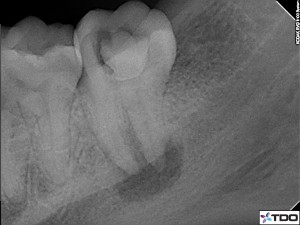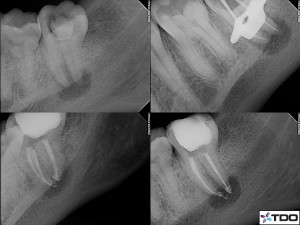When bacteria invade the human body, the outcome can be devastating.
This patient presented to our office after a few days of increasing discomfort. He had endodontic therapy initiated a year prior, but did not have the treatment completed. In addition to radiating pain on the left hand side of his face, the patient was febrile, sensitive to lingual palpation and complained of difficulty swallowing. He had found his way to his general dentist earlier in the day and by the time he got into our chair it was late in the afternoon. After the diagnosis was confirmed, I consulted with a local oral surgeon. Because both the referring doctor and the patient wanted to retain the tooth, we decided on the following plan:
1. Start patient on high dose antibiotics
2. Attempt to obtain drainage through the tooth
3. Postop visit at 12-18 hours for reevaluation
4. Place extraoral drain if necessary(by oral surgeon)
5. Upon improvement, complete endodontic therapy
Copious drainage was obtained from the distal canal upon establishing patency at the first visit. This was facilitated by placement of a microsuction into the canal. The tooth drained for approximately 30 minutes. All canals were prepared fully to working length in the presence of Sodium Hypochlorite and assisted by the EndoActivator. After dressing with Calcium Hydroxide, the patient was dismissed. He started his antibiotics and was reappointed for the next morning.
The next morning, he still had some lingual sensitivity to palpation, and the infection appeared to have continued its spread to the submandibular space. There was notable expansion and redness from the inferior border of the mandible extending to the midline. The patient was referred to the oral surgeon, where an extraoral drain was placed inferior to the border of the mandible.
Approximately one week later, the patient was seen for an additional follow up. After anesthetizing the patient, rubber dam isolation and removal of the provisional and calcium hydroxide, patency was verified on each of the canals. Additional drainage was found on the distal canal. Again the microsurgical suction was used to facilitate removal of the drainage, draining the tooth for nearly 45 minutes. The tooth was irrigated with Sodium Hypochlorite and CaOH was again placed. The oral surgeon removed the drain a day or two later.
Ten days later, at the final treatment visit, the CaOH was removed, the canals were initially irrigated and dried using paper points. The tooth was then irrigated using the Piezo Flow and EndoActivator in conjunction with Sodium hypochlorite. After irrigation and multiple recapitulations, treatment was completed. The patient had experienced significant relief from discomfort and healing since the removal of the drain, and 72 hours post-obturation, the patient felt great.
Because of the acute nature of the situation and the coordinated care provided by the oral surgeon, we were able to avoid what could have been a disastrous outcome. I look forward to seeing the recall on this case.

